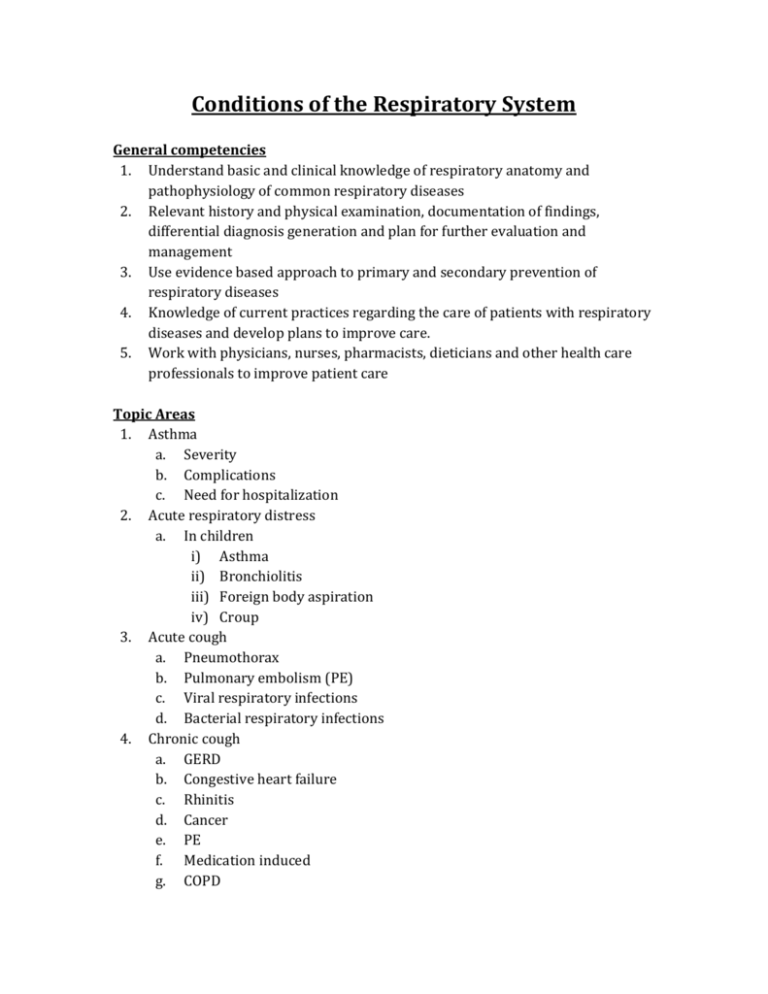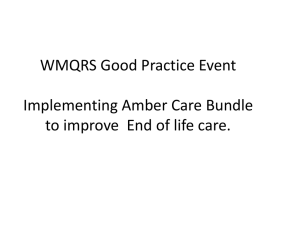Conditions of the Respiratory System
advertisement

Conditions of the Respiratory System General competencies 1. Understand basic and clinical knowledge of respiratory anatomy and pathophysiology of common respiratory diseases 2. Relevant history and physical examination, documentation of findings, differential diagnosis generation and plan for further evaluation and management 3. Use evidence based approach to primary and secondary prevention of respiratory diseases 4. Knowledge of current practices regarding the care of patients with respiratory diseases and develop plans to improve care. 5. Work with physicians, nurses, pharmacists, dieticians and other health care professionals to improve patient care Topic Areas 1. Asthma a. Severity b. Complications c. Need for hospitalization 2. Acute respiratory distress a. In children i) Asthma ii) Bronchiolitis iii) Foreign body aspiration iv) Croup 3. Acute cough a. Pneumothorax b. Pulmonary embolism (PE) c. Viral respiratory infections d. Bacterial respiratory infections 4. Chronic cough a. GERD b. Congestive heart failure c. Rhinitis d. Cancer e. PE f. Medication induced g. COPD 5. 6. 7. h. Pertussis i. Foreign body Causes of stridor a. Croup b. Anaphylaxis c. Foreign body (airway or esophagus) d. Retropharyngeal Abscess e. Epiglottitis Pneumonia a. Types: Bacterial, viral, atypical pathogens Upper respiratory tract infection (URTI) a. Viral vs bacterial causes b. Epiglotitis c. Retropharyngeal abscess d. Bacterial sinusitis e. Otitis externa/media, mastoiditis f. Pharyngitis For each topic area 1. Epidemiology 2. Anatomy 3. Pathophysiology/Etiology 4. Risk factors 5. History and physical exam 6. Diagnostic Tests 7. Differential diagnosis 8. Management 9. Psychosocial implications Highlighted teaching points 1. Risk Factors a. For complicated course of pneumonia and hospitalization 2. History and physical exam a. Upper vs. lower respiratory symptoms b. In patients with a diagnosis of pneumonia i. Assess the risks for unusual pathogens (e.g., a history of tuberculosis, exposure to birds, travel, HIV infection, aspiration) ii. If demonstrate early signs of respiratory distress; assess, and reassess periodically, the need for respiratory support c. In a patient with upper respiratory symptoms: 3. 4. 5. i. Differentiate viral from bacterial infection d. Given a history compatible with otitis media, differentiate it from otitis externa and mastoiditis Diagnostic tests a. In patients of all ages with respiratory symptoms (acute, chronic, recurrent) i. Confirm the diagnosis and determine severity of asthma by appropriate use of history, physical examination, spirometry. ii. Distinguish asthma or bronchiolitis from croup and foreign body aspiration b. In a child presenting with a clear history and physical examination compatible with mild to moderate croup, make the clinical diagnosis without further testing c. In a patient with signs and symptoms of pneumonia, do not rule out the diagnosis on the basis of a normal chest X-ray film Differential Diagnosis a. In patients presenting with an acute cough i. Include serious causes (e.g., pneumothorax, pulmonary embolism) in the differential diagnosis. b. In a child with acute respiratory distress i. Distinguish asthma or bronchiolitis from croup and foreign body aspiration through history and physical examination. c. Generate a differential diagnosis i. Acute cough ii. Persistent/recurrent cough iii. Stridor iv. Wheezing d. Pneumonia i. Include in differential of non-specific symptoms (e.g., deterioration, delirium, abdominal pain), include pneumonia in the differential diagnosis. ii. Generate a differential diagnosis of lower respiratory tract infections and subtypes Management a. Acute asthma exacerbation: i. Treat the acute episode (e.g., use beta-agonists repeatedly and early steroids, and avoid under-treatment) ii. Rule out co-morbid disease (e.g., complications, congestive heart failure, chronic obstructive pulmonary disease). b. c. d. e. iii. Determine the need for hospitalization or discharge (based on risk of recurrence or complications, patient expectations and resources). For the ongoing (chronic) treatment of an asthmatic patients: i. Management plan including: 1. Self‐monitoring 2. Self‐adjustment of medication 3. When to consult For a known asthmatic patient with ongoing or recurrent symptoms: i. Assess severity ii. Assess compliance with medications iii. Recommend lifestyle adjustments (e.g., avoiding irritants, triggers) to improve control In patients with croup: i. Identify the need for, and provide, respiratory assistance (e.g., assess ABCs, fatigue, somnolence, paradoxical breathing, in drawing) ii. Use of steroids iii. Plan for and anticipate recurrence of the symptoms Confirmed diagnosis of pneumonia: i. New diagnosis: in patients with pre-‐‐existing medical problems (e.g., asthma, diabetes, congestive heart failure 1. Treat both problems concurrently (e.g., with prednisone plus antibiotics). 2. Adjust the treatment plan for pneumonia, taking into account the concomitant medical problems (e.g., be aware of any drug interactions, such as that between warfarin [Coumadin] and antibiotics). ii. Make rational antibiotic choices iii. Ensure appropriate follow-up care iv. Arrange contact tracing when appropriate v. For patients not responsive to treatment: 1. Revise the diagnosis (e.g., identify other or contributing causes, such as cancer, chronic obstructive pulmonary disease, or bronchospasm) 2. Consider atypical pathogens (e.g., Pneumocystis carinii,TB) 3. Diagnose complications (e.g., empyema, pneumothorax). 4. Modify the therapy appropriately (e.g., change antibiotics). vi. Prevention: 1. f. Identify patients who would benefit from immunization or other treatments (e.g., flu vaccine, Pneumovax, ribavarine) to reduce the incidence of pneumonia. In patients with URTI: i. High-risk patients (e.g. HIV/COPD/cancer) with upper respiratory infections: 1. Aggressively search for complications 2. Follow up more closely 3. Take preventive measures (e.g., use flu and pneumococcal vaccines) ii. Treat early to decrease individual and population impact (e.g., with oseltamivir phosphate [Tamiflu], amantadine). References: 1. College of Family Physicians of Canada. (2010). Defining Competence for the purposes of certification by the College of Family Physicians of Canada: The evaluation objectives in family medicine. Mississauga, ON.








